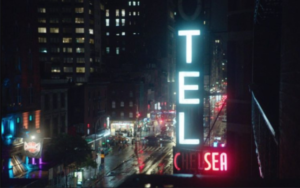DREAMING WALLS: INSIDE THE CHELSEA HOTEL: 3 ½ STARS. “shelter for dreamers.”
 The Hotel Chelsea, on west 23rd Street, tucked between Seventh and Eighth Avenue in Manhattan’s Chelsea, is the stuff of legend. Playwright Arthur Miller lived here for six years and said, “This hotel does not belong to America; there are no vacuum cleaners, no rules and no shame.”
The Hotel Chelsea, on west 23rd Street, tucked between Seventh and Eighth Avenue in Manhattan’s Chelsea, is the stuff of legend. Playwright Arthur Miller lived here for six years and said, “This hotel does not belong to America; there are no vacuum cleaners, no rules and no shame.”
An elderly tenant, seen in the new documentary “Dreaming Walls: Inside the Chelsea Hotel,” now playing in theatres, says, “It’s a fantasy land where people go to get away from reality.”
Opened in 1884, for more than a century it was a stand-alone example of bohemianism, immortalized in songs by Bob Dylan (“Sara”), Jefferson Airplane (“Third Week in the Chelsea”) and most famously, Leonard Cohen’s “Chelsea Hotel #2.” It’s featured in films like Andy Warhol’s “Chelsea Girls” and the sensual “9½ Weeks.
Punk goddess Patti Smith lived there with photographer Robert Mapplethorpe. Abstract painter Mark Rothko had a studio in the dining room. Warhol superstar Edie Sedgwick almost accidentally burned it down and Nancy Spungen died there, allegedly (but probably not) at the hand of her boyfriend, Sex Pistol’s bass player Sid Vicious. Arthur C. Clarke wrote “2001: A Space Odyssey” while in residence and Jack Kerouac had a one-night stand there with Gore Vidal.
It is legendary, but the days of wild abandon, avant garde art and artists who traded apartments for paintings are long gone, a victim of changing times and gentrification. “Dreaming Walls: Inside the Chelsea Hotel” is a document of the dying days of a cultural legend and the birth of another boho-chic New York City hotel.
Directed by Belgian filmmakers Amélie van Elmbt and Maya Duverdiert, this is a fly-on-the-wall, impressionistic film that ignores the Chelsea’s rock n’ roll legacy, the scandals and notable sex acts. Instead, it contemplatively documents the (mostly) elderly residents of the Chelsea, who, in the words of Dylan Thomas, another former resident, refuse to “go gentle into that good night.”
A look at the hotel through the eyes of the people who lived there, who created their art there and raised their families there, paints a different picture of the storied building than we usually see. Strip away the sensationalism and a melancholy portrait of a bygone era emerges, framed by architect Philip Hubert’s ornate Victorian Gothic stained glass and wrought iron stairway designs. As construction of the Chelsea Mach 2 tears away at the memories of the remaining residents, they recollect the heart and soul of a place that, for decades, gave shelter to dreamers of all sorts.
Those days are gone now. The few remaining old timers, those who didn’t take the buyouts offered by developers, now must use service elevators to avoid upsetting the upscale, paying hotel guests. However, in this film at least, they keep the bohemian flame alive, even as the winds of change are try to extinguish it.
